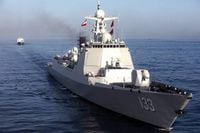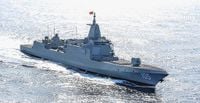China and Russia are set to conduct their annual joint naval exercise, "Joint Sea 2025," in the waters and airspace near Vladivostok, Russia’s far eastern port city, starting August 1, 2025. This marks the continuation of a growing military partnership between the two nations, reflecting a strategic alignment that has intensified over recent years.
The Chinese Defense Ministry confirmed on July 30, 2025, that the exercise will involve the People’s Liberation Army Navy working alongside Russia’s Pacific Fleet in the Sea of Japan, just across from Japan’s west coast. Senior Colonel Zhang Xiaogang, spokesperson for China’s Defense Ministry, emphasized that this exercise is part of an annual cooperation plan between the two militaries and is not aimed at any third country or linked to current international or regional tensions.
"This is an arrangement within the annual cooperation plan between the Chinese and Russian militaries. It is not targeted at any third party, nor is it related to the current international and regional situation," Zhang said during a regular press conference in Beijing.
The joint drills, dubbed Maritime Interaction 2025, will last five days and include a wide array of naval operations such as anti-submarine warfare, air defense, search-and-rescue missions, and "joint gun" exercises. The Chinese contingent will be led by the Type 052 guided-missile destroyer Shaoxing and the Urumqi, while the Russian side will be spearheaded by the large anti-submarine warfare ship Admiral Tributs. Diesel-electric submarines and naval aircraft from both countries will also participate, demonstrating the depth and complexity of the cooperation.
Following the drills, selected naval units from both countries will embark on their sixth joint maritime patrol in designated areas of the Pacific Ocean, further cementing their coordinated presence in the region. Zhang did not specify the exact dates or locations for this patrol but confirmed it would follow the conclusion of the exercises.
This year’s exercise near Vladivostok contrasts with last year’s Joint Sea drills, which took place off southern China in the South China Sea. The shift in location underscores the strategic flexibility of the two militaries and their intent to project power across a broader swath of the Pacific.
China and Russia’s military cooperation has grown significantly over the past two decades, with over half of their combined 113 joint drills since 2003 occurring in just the last six years, according to analysis by the Center for Strategic and International Studies’ China Power Project. While the two countries lack a formal military alliance, their cooperation is seen as a concerted effort to challenge longstanding U.S. military dominance in the Asia-Pacific region and to carve out spheres of influence.
European leaders have recently urged China to use its influence to pressure Russia to end the war in Ukraine, now entering its fourth year. However, Beijing has shown no indication of taking such steps. Instead, China continues to provide Russia with economic support, helping Moscow withstand Western sanctions imposed after its invasion of Ukraine.
Japan’s Defense Ministry, in its July 2025 annual report, expressed serious concern over China’s expanding military cooperation with Russia, highlighting the potential security risks posed by this growing partnership. The report underscores the strategic challenge that the Sino-Russian military relationship presents to regional stability, especially as their naval operations occur near Japanese waters.
In a pointed critique, Zhang Xiaogang also condemned the ongoing Resolute Force Pacific drills conducted by the U.S. Air Force in collaboration with Japan and other allies. These exercises, described by the U.S. military as the largest contingency-response drills ever conducted in the Asia-Pacific, aim to enhance readiness and mission execution under stress. Zhang accused the U.S. of "blindly flexing muscles in the Asia-Pacific region and attempting to use military drills as a pretext to gang up, intimidate and pressure other countries, and undermine peace and stability in the region."
Observers note that the last two days of the Joint Sea 2025 exercises, August 4 and 5, will overlap with a separate joint naval exercise between India and the Philippines in the South China Sea. This concurrent drill has been viewed as a demonstration of New Delhi’s support for the U.S. treaty ally amid ongoing territorial disputes with China.
Garrett Campbell, a retired U.S. Navy captain and adviser to NATO on Russian military strategy, recently wrote in the Foreign Policy Research Institute that the increase in bilateral military activities between China and Russia is tied to a shared strategic vision by Presidents Xi Jinping and Vladimir Putin. Campbell emphasized that Putin is committed to a long-term strategic confrontation with the West, a stance that aligns closely with China’s ambitions to reshape the regional security order.
The arrival of the Chinese guided-missile destroyers Shaoxing and Urumqi in Vladivostok on July 31 signaled the start of the five-day Joint Sea 2025 drill. Russian state media reported that the exercise would also include participation from diesel-electric submarines and naval aircraft, reinforcing the comprehensive nature of the operations. The Chinese and Russian navies will use this opportunity to enhance interoperability and demonstrate their combined maritime capabilities.
As this exercise unfolds, it highlights the deepening military ties between two of the world’s largest powers, a relationship that continues to ripple through the geopolitical landscape of the Asia-Pacific. With tensions simmering over territorial disputes, military posturing, and the ongoing conflict in Ukraine, the Joint Sea 2025 exercise is a clear signal of the evolving strategic dynamics in the region.





